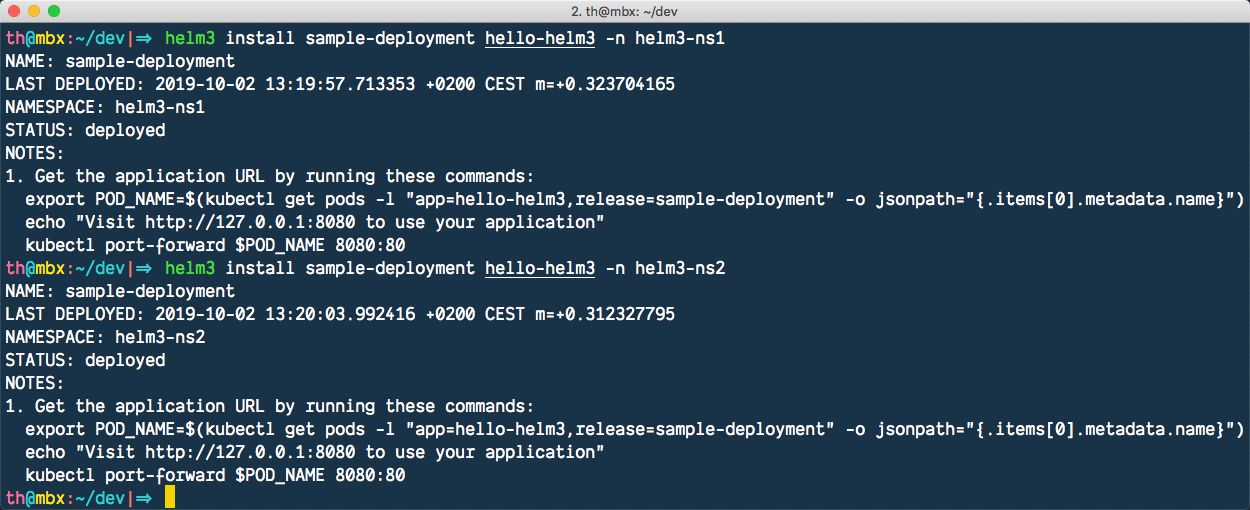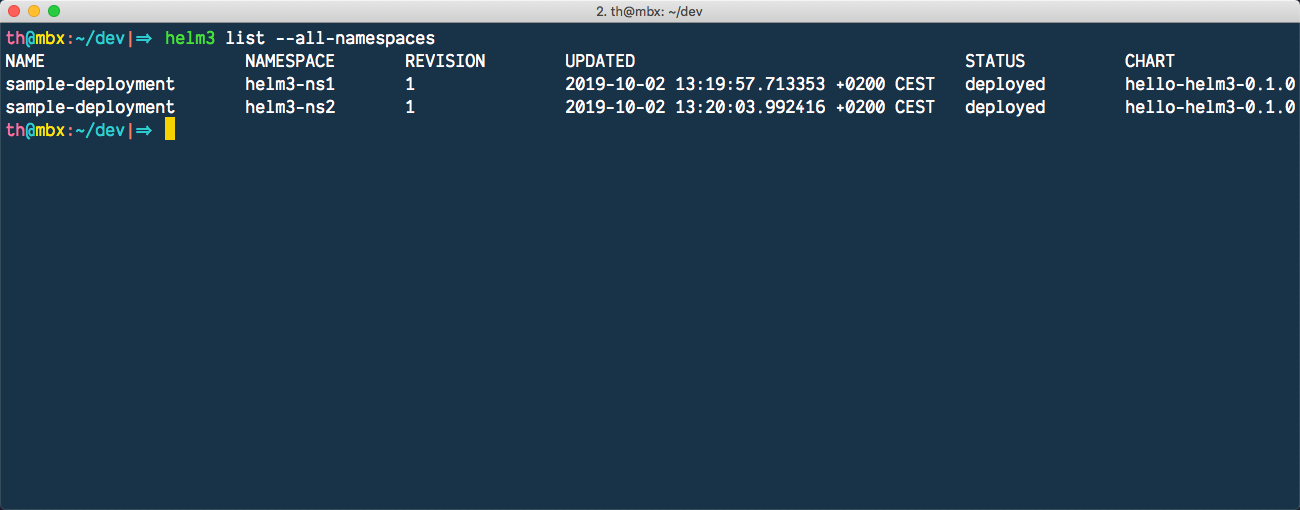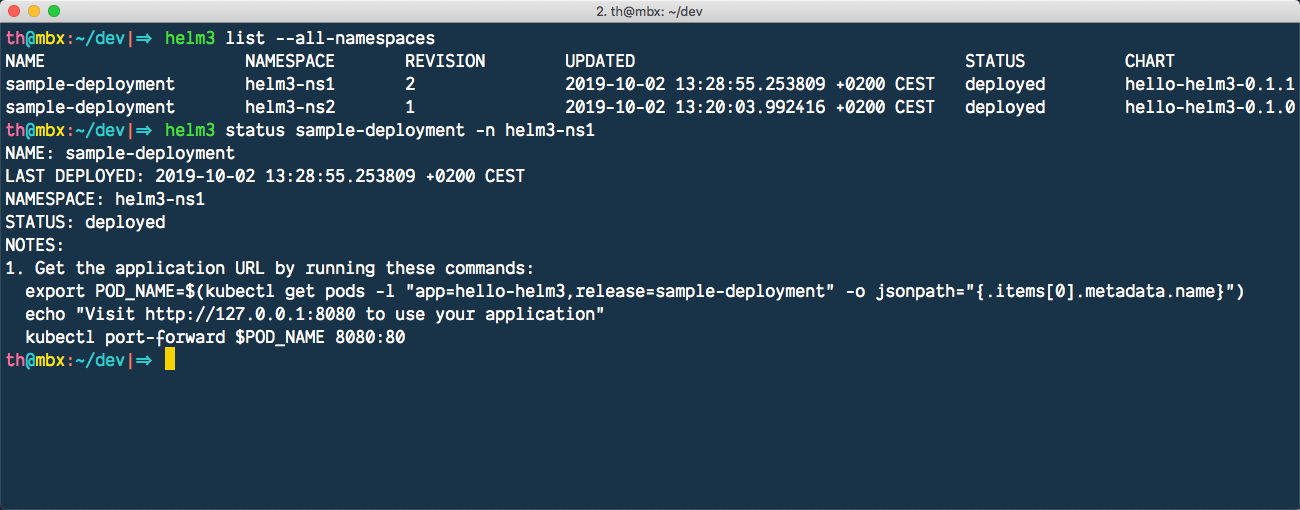Helm, is the package manager for Kubernetes. It allows you to install complex applications and maintain the entire application lifecycle using a lightweight and intuitive CLI. You can think of it as the npm or nuget for Kubernetes.
Helm is around for quite some time in the Kubernetes community. The project was started by Deis and Google and is an essential part of CNCF.
Since Helm 3 is available as a beta release, it is the right time to look into it. This article summarizes the upcoming changes and illustrates how Helm 3 could be used to build, distribute, and manage applications in Kubernetes.
What will change with Helm 3
Helm 3 will introduce some fundamental changes. The team has published already a series of articles on upcoming changes. Let’s quickly summarize those:
No more Tiller: Finally, the server-side component of Helm is gone. Tiller was the most significant disadvantage when considering using Helm. Instead, Helm 3 will rely on existing security patterns applied to the given cluster.
Chart Registries: Chart Registries will be implemented based on the Docker Distribution Project (aka Docker Registry v2). Helm will benefit from this move dramatically. Users can leverage existing Docker Registry v2 implementations such as Azure Container Registry (ACR) or the Docker Hub to distribute and consume their charts. Hosting Helm Charts in a Docker Registry is possible due to the Open Container Initiative (aka OCI) efforts. Docker Registries can store, maintain, and distribute any data - not just Docker Images. See the ORCAS project for example.
Library Charts: Helm 3 will introduce a new type of Charts. Library Charts are small application parts that are used to composite an overall application. Library Charts will be the reusable components of Charts in Helm 3. They don’t contain templates, so they can’t be deployed directly. They will become essential building blocks for developers to craft Application Charts and keep following the Don’t Repeat Yourself principle (DRY).
Release Management: In Helm 3, releases will be managed inside of Kubernetes using Release Objects and Kubernetes Secrets. All modifications such as installing, upgrading, downgrading releases will end in having a new version of that Kubernetes Secret. The Release Object acts as a pointer, pointing to the correct Secret for the current Release. Having both (the Release Object and the Secret) in the same Kubernetes Namespace as the actual Deployment allows us to deploy the same Release (with the same name) multiple times to a Kubernetes cluster.
Requirements: In 3, dependencies will no longer be maintained using the dedicated requirements.yaml file. Instead, the dependencies are directly listed inside of the Chart.yaml file, which means we as users have to care about fewer files.
Hands on Helm 3
First you’ve to install Helm 3. You can grab a precompiled binary from the releases page on GitHub. Once downloaded and extracted, you can either move the binary into your PATH, or create a symlink pointing to the executable. I’ve created a symlink called helm3 which will I use during the upcoming snippets.
cd ~/Downloads
# Download Helm3 Beta3
wget https://get.helm.sh/helm-v3.0.0-beta.3-darwin-amd64.tar.gz
# verify checksum
shasum -a 256 -c <<< "88ef4da17524d427b4725f528036bb91aaed1e3a5c4952427163c3d881e24d77 *helm-v3.0.0-beta.3-darwin-amd64.tar.gz"
# extract into ~/Downloads/helm3
mkdir helm3
tar -xzf helm-v3.0.0-beta.3-darwin-amd64.tar.gz --directory helm3
# create a symlink
ln -s ~/Downloads/helm3/darwin-amd64/helm /usr/bin/helm3
Verify Helm 3 installation
Because Tiller is gone, all you have to verify is the local installation using:
helm3 version
version.BuildInfo
{
Version:"v3.0.0-beta.3",
GitCommit:"5cb923eecbe80d1ad76399aee234717c11931d9a",
GitTreeState:"clean",
GoVersion:"go1.12.9"
}
Create a Chart and deploy it to Kubernetes
First let’s use the create sub command to create a new Application Chart.
cd ~/dev
helm3 create hello-helm3
Take a close look at the generated Chart.yaml it explicitly specifies the type as Application. If you want to create a reusable Library Chart, you have to change the type setting to library and remove the templates.
For the sake of this article, let’s stick with the simple Application Chart and bring our application to Kubernetes.
Helm3 allows multiple releases having the same name. For separation we will use regular Kubernetes namespaces.
# create two sample namespace
kubectl create namspace helm3-ns1
kubectl create namespace helm3-ns2
kubectl get ns | grep helm3
helm3-ns1 Active 3s
helm3-ns2 Active 2s
Having the namspaces in place, use helm3 install to install the previously created Chart to both namespaces.
cd ~/dev
helm3 install sample-deployment hello-helm3 -n helm3-ns1
helm3 install sample-deployment hello-helm3 -n helm3-ns2
Helm will provide some basic information about the deployment job for every deployment.

Verify the releases using helm3 list:
helm3 list --all-namespaces

Every deployment is tracked using a Kubernetes Secret in the same Namespace.
kubectl get secret -n helm3-ns1
NAME TYPE DATA AGE
sample-deployment.v1 helm.sh/release 1 1m26s
Modify the Chart and perform an upgrade
For demonstration purpose, udate the hello-helm3 Chart and set replicaCount: 2 in values.yaml. Remember to bump the version in Chart.yaml
helm3 upgrade sample-deployment hello-helm3 -n helm3-ns1
Helm will now upgrade the sample-deployment in Kubernetes Namespace helm3-ns1. As part of the upgrade process, a new Secret (sample-deployment.v2) will be deployed to the Namespace. In fact, Helm3 secrets contain the entire release in encrypted form. Once again, you can verify the overall state using helm3 list --all-namespaces

Clean up the Kubernetes Cluster
You can clean up your Kubernetes cluster usign helm3 uninstall, which will remove all Helm 3 artifacts from the currrent namespace.
helm3 uninstall sample-deployment -n helm3-ns1
helm3 uninstall sample-deployment -n helm3-ns2
kubectl delete ns helm3-ns1
kubectl delete ns helm3-ns2
Playground: Docker Image
If you want to play around with Helm 3 today, you can either install on of the pre-compiled beta binaries on your system, or you can use a tiny Docker Image. I have created and published it to the public Docker Hub at thorstenhans/helm3.
You can pull it directly via docker pull thorstenhans/helm3; further instructions are available in the Readme.
Recap
I am looking forward to the final Helm 3 release. Tiller was always the reason why I avoid using Helm in real-world environments. I can imagine many Kubernetes customers will jump on the Helm track with the upcoming release.
HTH